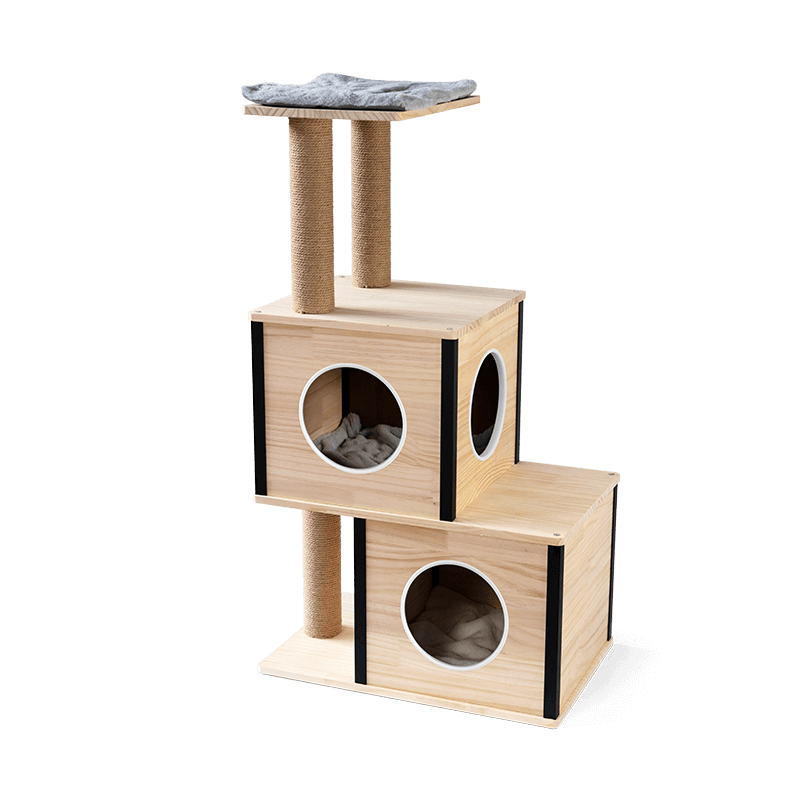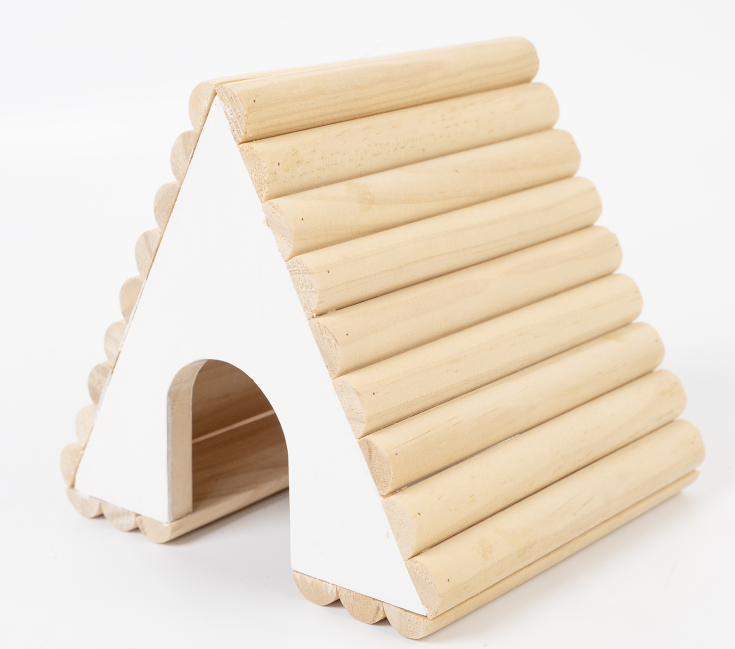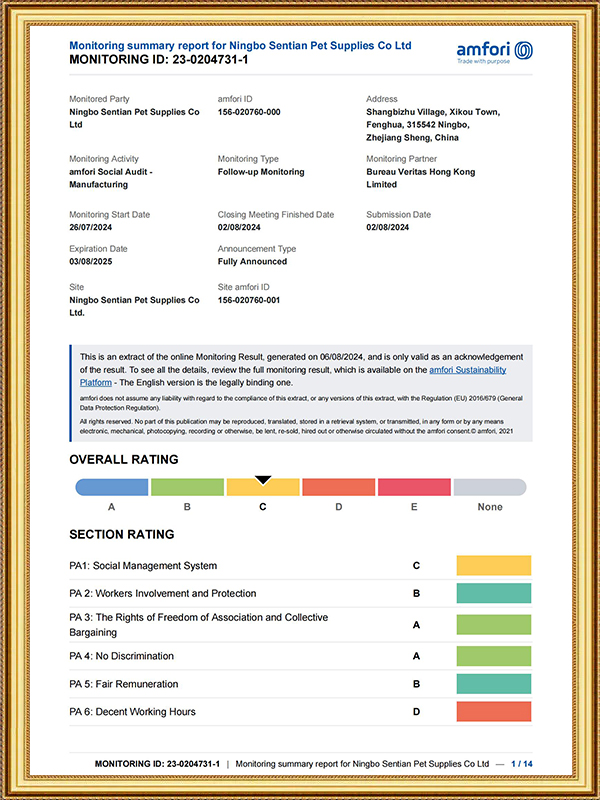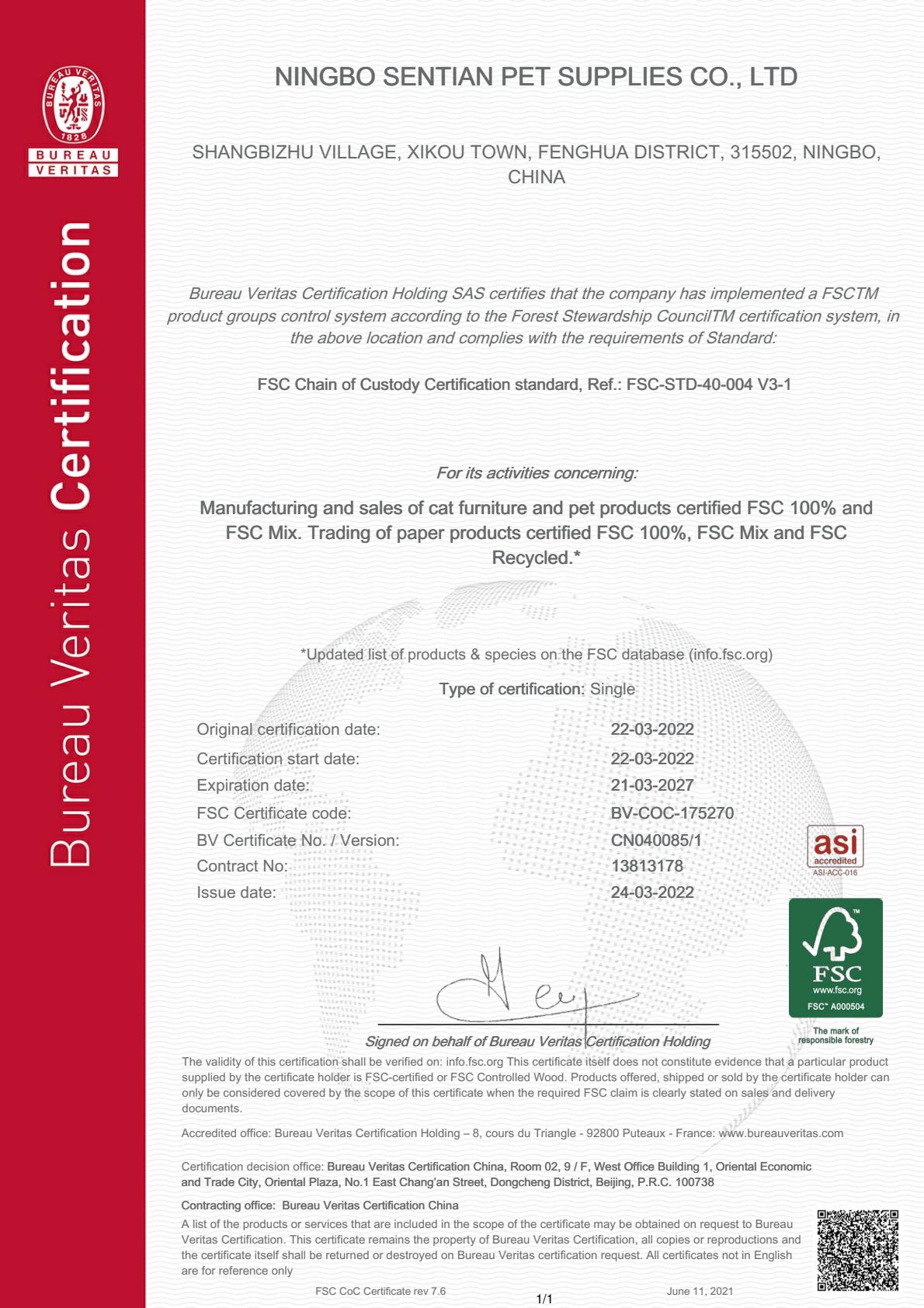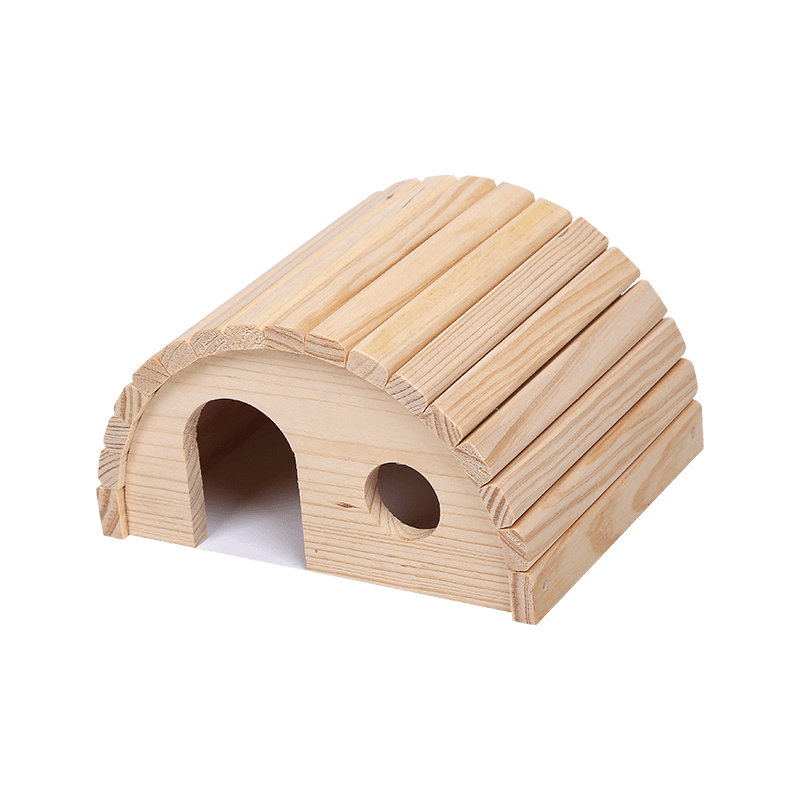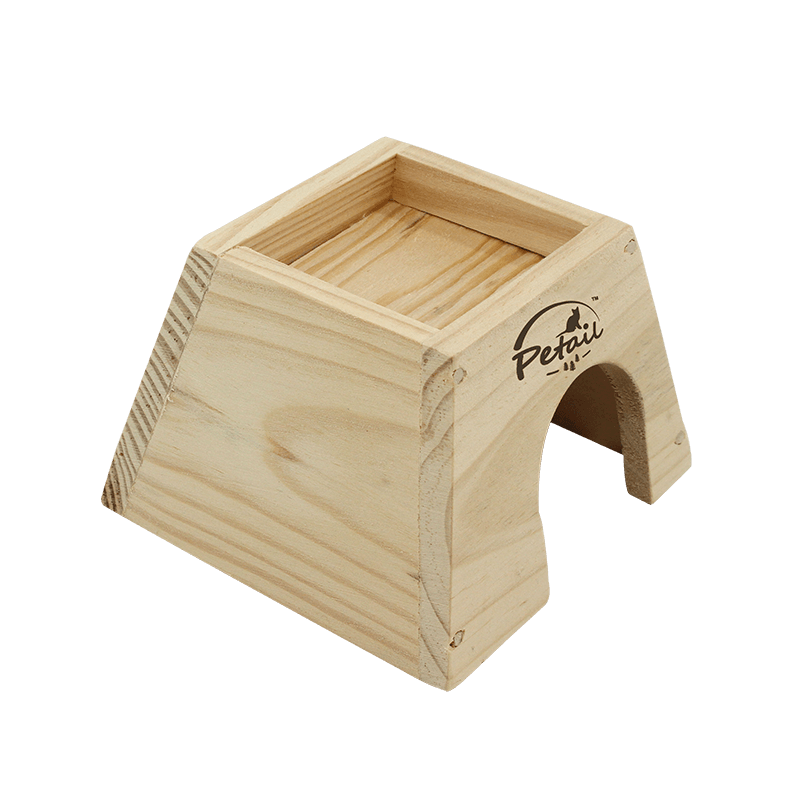We specialize in the production and sales of pet supplies, mainly cat climbing frames, cat furniture, cat toys, small animal toys, and bird toys.
Latest News
-

What are the safety hazards of installing wooden cat furniture
In modern families, wooden cat furniture not only provides a comfortable habitat for cats, but also becomes part of the home environment. However, safety hazards during installation and the environmental friendliness of furniture are the two aspects that consumers are most concerned about. Preventive measures for physical injury risksDuring the installation of wooden cat furniture, physical injury is a safety hazard that cannot be ignored. These risks include scratches, collisions, and accidental injuries from heavy objects. To this end, Ningbo Sentian has made in-depth considerations on the design and packaging of products to minimize these risks.First, the corners of the furniture are finely polished to ensure that all edges are rounded. This design effectively avoids scratches on the installer and cat during installation or use. In addition, in order to prevent accessories from being missing or damaged during transportation, Ningbo Sentian is equipped with a detailed list of accessories and installation guides for each piece of furniture to ensure that users can easily identify and use all accessories correctly. The product packaging uses high-strength materials, which can effectively prevent damage caused by collisions or extrusions during transportation. The importance of furniture stability and structural safetyThe stability and structural safety of furniture are key factors to ensure the safe use of cats. During the installation process, if the furniture is not assembled or fixed correctly, it may cause safety hazards such as shaking, tilting or even collapse during use. To this end, Ningbo Sentian provides detailed installation steps and guidelines to ensure that users can assemble in the correct order and method. During the installation process, users need to pay special attention to the tightening degree of the screws, both to ensure that the furniture is stable and to avoid over-tightening that causes wood cracking.In addition, Ningbo Sentian pays special attention to structural reinforcement in the design and production of furniture. For example, in multi-layer or high-structure cat climbing frames, special connection methods and reinforcement designs are used to ensure that the furniture can withstand cats' jumping and climbing during use. Such a design not only improves the safety of the furniture, but also extends its service life. Control of the release of harmful substances such as formaldehydeDuring the installation and use of wooden furniture, harmful substances such as formaldehyde may be released due to problems such as materials or glue, posing a potential threat to the health of cats and humans. Ningbo Sentian strictly controls the selection of materials and production processes to ensure that all products meet environmental standards.In terms of material selection, Ningbo Sentian gives priority to environmentally friendly and harmless materials, such as natural solid wood and environmentally friendly density boards. At the same time, in the selection of auxiliary materials such as glue, we follow the principle of environmental protection to ensure that the furniture will not release harmful substances during use. During the production process, Ningbo Sentian conducts strict quality control on each piece of furniture, including testing for harmful substances such as formaldehyde, to ensure that all furniture meets relevant environmental standards before leaving the factory.
View More -
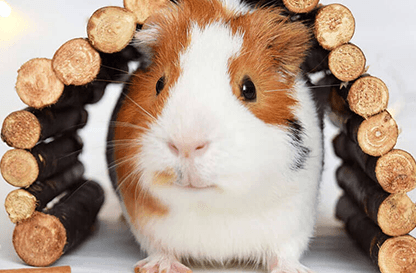
How to choose the installation location of wooden cat furniture
When choosing and installing wooden cat furniture, reasonable space layout and furniture size are crucial. Ningbo Sentian Pet Supplies Co., Ltd. offers a wide range of wooden cat furniture, from simple small cat beds to complex multi-layer cat climbing frames. To ensure the reasonable configuration of the furniture, users need to carefully measure the specific dimensions of the furniture before installation and evaluate the available home space to ensure that the furniture can be placed smoothly and will not hinder daily activities. At the same time, considering the activity habits of cats, the installation location should be spacious enough to prevent the furniture from being too crowded, which will affect the cat's play and rest. Light and ventilation conditions are also important considerations when choosing the installation location of wooden cat furniture. Although cats prefer a quiet resting environment, moderate light and good ventilation can help keep the furniture dry and clean, thereby extending its service life. Ningbo Sentian Pet Supplies Co., Ltd.'s wooden cat furniture is made of high-quality solid wood and has good weather resistance, but it still needs to avoid long-term exposure to strong sunlight or humid environments. Therefore, it is recommended to place the furniture in a location with soft light and good ventilation, such as near a window but away from direct sunlight, or near an indoor vent but away from direct cold wind. When choosing the installation location, you also need to fully consider the cat's activity habits and preferences. Cats, as natural hunters, usually prefer high and hidden spaces. Ningbo Sentian Pet Supplies Co., Ltd.'s wooden cat furniture has a unique design, including cat climbing frames suitable for cats to climb and play, as well as cat beds that provide hidden spaces. In order to stimulate the curiosity and activity desire of cats, it is recommended to set the furniture in areas where cats often move, such as the corner of the living room, next to the bedroom window sill or balcony. At the same time, considering the characteristics of cats who like to observe the surrounding environment, the installation location of the furniture should be as close to the window or door as possible so that the cat can easily observe the dynamics of the outside world. Safety is a factor that cannot be ignored when choosing the installation location of wooden cat furniture. Avoid installing furniture near wires, sockets or heat sources to prevent cats from electric shock or injury during play. In addition, since cats may chew furniture out of curiosity, it is recommended to place furniture away from flammable and explosive items. In order to prevent furniture from becoming an obstacle or interference factor in home life, users should ensure that the installation location of furniture will not hinder daily activities.
View More -

What are the advantages of the multi-level structural design of carpet cat furniture
In today's fast-paced life, pet cats are part of the family, and their physical and mental health is increasingly concerned. Carpet Cat Furniture, with its unique multi-level structure design, perfectly matches the natural habits of cats, providing a safe and interesting activity space to promote the physical and mental development of cats. Design concept that conforms to cat instinctsCats are born climbers and explorers, and like to observe the surrounding environment from a high place. The design inspiration of Carpet Cat Furniture comes from this characteristic. Our furniture meets the climbing needs of cats through carefully designed multi-level platforms and climbing paths, promoting their physical exercise and psychological development. In the process of climbing, cats can not only exercise their muscles and enhance coordination, but also effectively consume excess energy, reduce anxiety and stress, thereby improving the overall quality of life. Optimize space utilization and adapt to diverse environmentsIn modern homes, the rational use of space is crucial. The multi-level structure design of Carpet Cat Furniture fully considers this and can provide sufficient activity area in a limited space. Whether it is a spacious living room or a compact small room, our furniture can be easily integrated and become a natural extension of the home environment. Through clever layered layout, Carpet Cat Furniture not only improves the efficiency of space use, but also adds visual layering and beauty, making the home environment more harmonious. Enhance interactivity and bring pets and owners closerCarpet Cat Furniture not only focuses on the needs of cats, but also pays more attention to the interaction between pets and owners. Our design incorporates multiple interactive elements, such as hidden toys and climbing ropes, which not only attract the attention of cats, but also stimulate their desire to explore. In the process of interacting with cats, pet owners can enhance their feelings for each other and establish a closer connection. By observing the activities of cats on furniture, owners can have a deeper understanding of cats' habits and needs, so as to provide more caring care and enhance the happiness of pets' lives. Durability and safety are equally important to ensure the health of catsIn the design of Carpet Cat Furniture, durability and safety are always our focus. Our furniture uses high-quality solid wood frames and environmentally friendly sponge fillings to ensure the stability and durability of the structure. In order to ensure the safety of cats during climbing, we introduced anti-slip and soft cushion treatment in the design to effectively reduce the risk of slipping and injury. In addition, all furniture has undergone strict environmental protection treatment and quality testing to ensure that it is non-toxic and harmless, providing a safe and healthy resting environment for cats.
View More -

What are the characteristics of carpet cat furniture design
In today's rapidly developing pet supplies market, Sentian Pet Supplies has always taken the health and comfort of pets as its core concept and launched a series of products - Carpet Cat Furniture. This series of products not only reflects a deep understanding of natural elements, but also innovates in structural design and color matching, aiming to provide cats with a safe and comfortable living environment while enhancing the overall beauty of the home. Integrating natural elements to create a warm atmosphereSentian firmly believes in the importance of natural elements in pet life, so in the design of Carpet Cat Furniture, natural materials such as solid wood, wool, cotton and linen are selected. The solid wood frame of the product is made of high-quality logs, which are finely polished and environmentally friendly to ensure the stability and durability of the furniture, and exude a natural atmosphere, allowing cats to get close to nature. This design not only provides a safe and healthy resting environment for cats, but also creates a warm and comfortable home atmosphere. In addition, the use of natural fiber fabrics such as wool and cotton and linen is not only soft to the touch and breathable, but also effectively inhibits the growth of bacteria, ensuring the health of cats, truly achieving the dual goals of people-oriented and caring for pets. Innovative structural design to meet diverse needsThe design team of Sentian Pet Supplies has innovatively designed a variety of Carpet Cat Furniture by deeply studying the behavioral habits and preferences of cats and combining ergonomic principles. These carpet-style cat furniture not only have a unique appearance, but also have achieved breakthroughs in functionality and durability. For example, the multi-level structural design of the multi-functional climbing frame provides ample exercise space, while incorporating a rest area and toy hooks to meet the multiple needs of cats for playing, resting and observing the outside world. It is worth mentioning that the product is also very careful in detail processing. The edge of the carpet adopts a non-slip design to prevent cats from slipping and getting injured while playing; the pillars of the climbing frame are padded, which not only increases comfort but also prevents cats from scratching furniture, fully reflecting Morita's high attention to pet safety. Focus on color matching to enhance home beautyIn terms of color design, Sentian's designer team has carefully selected and focused on integration and coordination with the home environment. The warm and soft colors selected, such as beige, gray and brown, not only conform to the visual habits of cats, but also match various home styles to enhance the overall beauty. In addition, Sentian also offers a variety of styles and sizes to choose from, ensuring that consumers can find Carpet Cat Furniture that suits them, whether they have a small apartment or a large space.
View More -

What are the effects of manufacturing technology on the performance of wooden cat furniture
In today's pet industry, the quality and performance of wooden cat furniture directly affect the pet's life experience. Ningbo Sentian Pet Supplies Co., Ltd. is committed to providing safe, comfortable and durable furniture products for pets with its excellent manufacturing process and strict control of material processing. Material processing: Laying the foundation for high performanceMaterial processing is the core link of the manufacturing process and is directly related to the overall performance of the product. Ningbo Sentian Pet Supplies Co., Ltd. insists on selecting high-quality solid wood such as oak and maple in this field. These woods not only have moderate hardness and high bending strength, but also have excellent wear resistance and durability, providing a solid physical foundation for the long-term use of furniture. The company introduces advanced drying technology to ensure that the moisture content of the wood remains within the ideal range, avoiding deformation and cracking caused by humidity fluctuations, thereby effectively improving the dimensional stability and service life of the furniture. Structural design: Achieving precise execution and ensuring stabilityThe structural design of furniture is a key factor in determining its stability and durability. Ningbo Sentian Pet Supplies Co., Ltd. strictly follows the design drawings during the production process, and through precise mechanical processing and manual debugging, ensures that the structural components of each piece of furniture can be accurately docked to form a stable support system. Especially in multi-layer climbing frames and furniture with complex structures, the company uses the most advanced CNC processing technology to ensure the accuracy and firmness of each connection point, effectively avoiding the problem of structural instability caused by manufacturing errors. In addition, the company also pays attention to the overall aesthetics of the furniture during design. Through fine polishing and appearance treatment, each product shows an elegant visual effect on the basis of structural stability. Improved durability: exquisite craftsmanship and extended service lifeDurability is an important criterion for measuring the performance of wooden cat furniture. Ningbo Sentian Pet Supplies Co., Ltd. focuses on improving the durability of furniture through exquisite craftsmanship during the manufacturing process. The company uses high-quality coatings and glues, which not only ensure the smoothness and waterproof and wear-resistant properties of the furniture surface, but also enhance the hardness and toughness of the wood. At the connection parts, high-strength connectors or precise mortise and tenon structures are used to ensure that the furniture will not loosen or break during long-term use. In addition, the company also pays attention to the maintainability of furniture, designing structures that are easy to disassemble and clean, so that the products can still maintain good performance and appearance after long-term use.
View More -

How to ensure the stability of wooden cat furniture
In the modern pet products market, the quality and safety of cat furniture have increasingly become the focus of consumers. Ningbo Sentian Pet Supplies Co., Ltd. is well aware of this and is committed to providing high-quality, stable and safe cat furniture to ensure that every pet and its owner can enjoy a high-quality use experience. Material selection: high-standard environmentally friendly solid woodIn the construction of furniture, the choice of materials is crucial. Ningbo Sentian Pet Supplies Co., Ltd. selects high-quality solid wood as the main material, including oak, maple and pine. These woods not only have moderate hardness, but also have excellent bending strength and wear resistance, which can provide a solid support foundation for furniture. The company takes strict control measures on the procurement of raw materials to ensure that all wood comes from certified sustainably managed forests. This not only ensures the environmental protection of the product, but also provides a strong guarantee for the quality and stability of the furniture. Structural design: scientific and reasonable mechanical layoutThe structural design of wooden cat furniture directly affects its stability. Based on the principles of mechanics, the design team of Ningbo Sentian Pet Supplies Co., Ltd. optimizes the layout and support structure of furniture through precise calculations and simulations. For example, the multi-layer climbing frame adopts a frame design, and the main beam is made of solid wood to form a stable support network. The resting platform and climbing ladder are reinforced to ensure that cats can get enough support when jumping and resting. In addition, the connection parts of the furniture adopt high-strength connectors or precision mortise and tenon structures, which further enhances the overall stability and ensures that it is not easy to loosen or deform during use. Manufacturing process: exquisite craftsmanship and strict quality controlThe manufacturing process is an important factor affecting the quality of wooden cat furniture. Ningbo Sentian Pet Supplies Co., Ltd. has advanced production equipment and a strict quality control system to ensure that every piece of furniture is finely polished and rigorously assembled. Before processing, the wood is strictly dried to ensure that its moisture content is moderate to avoid deformation caused by humidity changes. The edges and joints of the furniture are finely polished to avoid potential damage to cats by sharp corners. During the assembly process, the company uses professional assembly processes and tools to ensure that all parts fit tightly, thereby improving the overall stability of the furniture.
View More -

What are the precautions for cleaning and maintaining cat scratch mat
In modern home environments, Cat Scratch Mat, as an important scratching tool for cats, not only provides cats with a comfortable scratching experience, but also effectively protects furniture from damage. However, due to its frequent contact with cats' claws, Cat Scratch Mat is very easy to accumulate hair, dust and dirt. If it is not cleaned regularly, it may affect the appearance of the product and even breed bacteria, posing a potential threat to the health of cats. Therefore, it is crucial to keep the Cat Scratch Mat clean. Cleaning stepsCleaning tool preparationBefore cleaning, it is crucial to choose the right tools. It is recommended to use a soft damp cloth or a slightly damp towel to avoid scratching or damaging the surface of the Cat Scratch Mat. If necessary, a mild detergent or a cleaner designed for pets can be used to ensure safety during the cleaning process.Surface dirt removalFirst, use a soft damp cloth to gently wipe the surface of the Cat Scratch Mat to remove attached hair, dust and loose dirt. For stubborn stains, it is recommended to apply a small amount of mild detergent or pet-specific cleaner, gently wipe the stain, and then rinse thoroughly with clean water to ensure that there is no residual detergent.Avoid over-wettingDuring the cleaning process, be sure to control the use of water to avoid over-wetting the Cat Scratch Mat. Excessive moisture may penetrate into the material and cause it to deform or damage. After cleaning, use a clean towel to absorb excess moisture on the surface and place it in a well-ventilated environment to dry naturally to ensure that it is dry and intact.Inspection and replacementWhile cleaning, be sure to carefully check the wear of the Cat Scratch Mat. If the scratching surface is found to be severely worn or deformed, it is recommended to replace it in time to ensure that the cat's scratching needs are met while protecting the home environment. Maintenance recommendationsReplace the scratching surface regularlyIf the Cat Scratch Mat is equipped with a replaceable scratching surface, it is recommended to replace it regularly to maintain its scratching effect and durability. When replacing, make sure that the new scratching surface fits tightly with the bottom to avoid loosening or falling off and affecting the use effect.Avoid direct sunlight and humid environmentThe environment in which the Cat Scratch Mat is used is equally important. Prolonged exposure to sunlight or in a humid environment may cause the material to age, deform or mold. Therefore, it is recommended to place the Cat Scratch Mat in a well-ventilated area away from direct sunlight and humidity to extend its service life.Regular inspection and adjustmentCheck the Cat Scratch Mat regularly to ensure its stability and safety. If any loose or damaged parts are found, they should be repaired or replaced in time. At the same time, according to the cat's body shape and scratching habits, adjust the position and height of the Cat Scratch Mat appropriately to ensure its comfort and practicality.
View More -

What are the material characteristics of cat scratch mat
Design featuresCat Scratch Mat fully incorporates the concept of environmental protection in the design process. All materials selected are natural, non-toxic, harmless and environmentally friendly materials to ensure the health and safety of cats during use. This product simulates the natural environment through innovative texture design, effectively stimulating the cat's desire to scratch. In addition, Cat Scratch Mat is equipped with a variety of interactive toys, such as small balls and bells, to enhance the fun of the product and promote interaction and emotional communication between cats and pet owners.In terms of cleaning and maintenance, Cat Scratch Mat uses wear-resistant and easy-to-clean materials, making daily maintenance more convenient. Users only need to wipe gently with a damp cloth to easily remove hair, dust and dirt on the surface, ensuring that the product is always clean and hygienic. In order to meet the needs of cats of different sizes and preferences and various home styles, Cat Scratch Mat provides a variety of sizes and styles to choose from, fully considering the personalized needs of consumers. Material characteristicsHigh-density environmentally friendly cardboardThe core material of Cat Scratch Mat is specially treated high-density environmentally friendly cardboard, which has excellent wear resistance and durability, can withstand the scratching of cats' sharp claws, and significantly extend the service life of the product. This cardboard material is non-toxic and harmless, ensuring the safety of cats and pet owners. At the same time, the elastic design of the cardboard provides cats with a comfortable scratching experience, effectively avoiding damage to cats' claws.High-quality sisal fiberAs an important component of Cat Scratch Mat, sisal fiber is derived from natural sisal plants and has environmentally friendly and sustainable characteristics. Its addition not only enhances the durability of the product, but also can withstand longer scratching without being easily damaged. The rough texture of sisal fiber can effectively stimulate the cat's desire to scratch, meet its natural needs, and provide an ideal scratching environment for cats.Exploration of other environmentally friendly materialsNingbo Sentian Pet Supplies Co., Ltd. actively explores and tries other environmentally friendly materials, such as corn leaves and seaweed, to enrich the material selection of Cat Scratch Mat and further meet the diverse needs of consumers. These new materials are also non-toxic, harmless, environmentally friendly and healthy, creating a safer and healthier scratching environment for cats.
View More -

What are the advantages of material selection for corrugated cat scratcher
Material advantages and environmental protection characteristics of corrugated cat scratching boardsCorrugated Cat Scratcher is an innovative product in modern pet supplies, and its core material is corrugated paper. This material is widely used in various industries due to its excellent wear resistance and durability, especially in the packaging and construction fields. In the pet supplies industry, the excellent performance of corrugated paper has also been fully reflected.The wear-resistant properties of corrugated paper make corrugated cat scratching posts effective in dealing with the frequent scratching needs of cats. Compared with other common materials, corrugated paper has greater toughness and resistance to wear and tear, ensuring that it maintains good appearance and functionality after long-term use. This durability not only extends the service life of the product, but also significantly reduces the frequency of replacement of cat scratching posts by pet owners, thus bringing substantial financial savings to users. Selection of environmentally friendly materials and sustainable developmentThe design concept of the corrugated cat scratching board not only focuses on the pet's use experience, but also reflects a sense of responsibility for the environment. In addition to corrugated paper, the product also uses other environmentally friendly materials such as solid wood and sisal fiber. These materials not only perform well in terms of performance, but also show significant advantages in environmental protection.Solid wood serves as the support structure for the corrugated cat scratching board, providing a solid foundation for the product. Its natural texture and beautiful appearance not only enhance the overall beauty of the product, but also add a sense of nature and harmony to the home environment. Importantly, as a renewable resource, the use of solid wood complies with the principles of sustainable development and reduces the burden on the environment.Sisal fiber is cleverly used in the corrugated structure of the cat scratching post. Its wear-resistant and scratch-resistant properties have made sisal fiber widely recognized in the field of pet products. Additionally, as a natural plant fiber, the use of sisal does not have a negative impact on the environment or pet health. This choice of environmentally friendly materials highlights the Sentian Pet brand’s care for the earth and emphasis on pet health. Ease of cleaning and maintenanceThe material selection of the corrugated cat scratching board also takes into account the convenience of daily cleaning and maintenance. Due to the characteristics of corrugated paper and sisal fiber, dust and hair are not easily accumulated on the surface of the product. Users can easily remove stains by simply wiping with a vacuum cleaner or soft cloth. For stubborn stains, use a mild detergent and a damp cloth to ensure the product always stays clean and tidy.In addition, the lightweight nature of corrugated paper and solid wood makes corrugated cat scratching posts more convenient during handling and storage. Users can easily fold or roll the product, saving valuable space resources. This humanized design not only improves the product use experience, but also saves users time and energy.
View More -
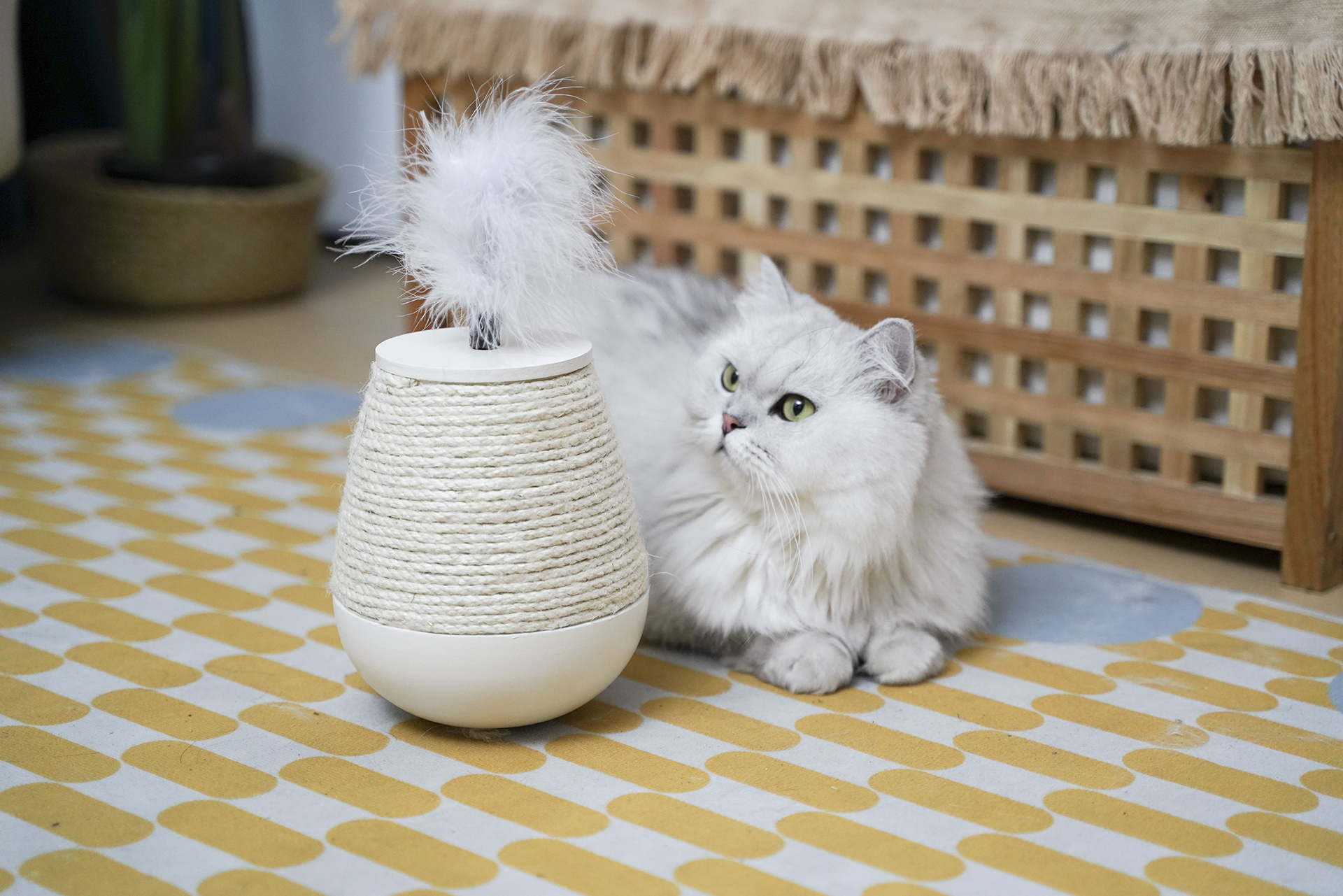
What is the function of the corrugated design of the corrugated cat scratcher
In the modern pet supplies market, the Corrugated Cat Scratcher stands out with its unique corrugated design, making it the ideal scratching tool for cats. This design not only improves the flexibility and durability of the product, but also provides cats with a more comfortable experience. Excellent flexibility and durabilityThe corrugated structure of the Corrugated Cat Scratcher significantly enhances its flexibility and durability. Compared with traditional flat cat scratching posts, the corrugated design can effectively absorb and disperse the impact force generated when cats scratch. This design concept not only extends the service life of the product, but also ensures the comfort and safety of cats during long-term play. It has been verified through actual use that the corrugated structure significantly reduces material damage caused by frequent scratching. Even after long-term use, the Corrugated Cat Scratcher can still maintain excellent appearance and performance, providing a stable and long-lasting playing environment for cats. Stimulate cats’ interest in scratching and desire to exploreCats are hunters by nature and are full of curiosity about new things. The Corrugated Cat Scratcher's corrugated design was developed based on this feature. Its unique corrugated structure not only improves the visual effect, but also provides cats with a rich tactile experience during the scratching process. When cats scratch, they can feel feedback from different angles and strengths. This dynamic change greatly stimulates the cat's interest in scratching and desire to explore. Through observation, we found that cats showed great interest in Corrugated Cat Scratcher, frequently scratching on it and carefully exploring every detail of the ripples with their claws. This interaction not only satisfies the cat's natural needs, but also effectively enhances its muscle strength and coordination. Improve scratching efficiency and comfortThe corrugated design is not only aesthetically pleasing, but also plays an important role in improving scratching efficiency and comfort. Compared with traditional flat cat scratching posts, the corrugated structure better fits the shape of the cat's claws, making the scratching action more natural and smooth. This design reduces the cat's resistance during scratching, improves scratching efficiency, and enables cats to meet their natural needs faster. In addition, the slight massage effect brought by the corrugated structure can effectively relax the cat's muscles and joints, relieve fatigue caused by long-term activities, and thus improve its overall comfort. Easy cleaning and maintenanceDuring the product design process, Corrugated Cat Scratcher fully considered the convenience of daily cleaning and maintenance. Its corrugated structure makes it difficult for dust and hair to accumulate, and users can easily remove stains by simply wiping with a vacuum cleaner or soft cloth. For stubborn stains, use a mild detergent and a damp cloth to ensure the product always stays clean. This convenient cleaning method not only improves the user experience, but also creates a more hygienic playing environment for cats.
View More -

Importance of ventilation and lighting in cat house
In the design and construction process of Cat House, ventilation and lighting are indispensable key elements. These two factors not only directly affect the quality of life of cats, but are also closely related to their health and mental state. Ventilation system design and effectivenessVentilation is critical to air quality in your cat house. A good ventilation system can effectively remove harmful substances from the room, including cat body odor, excrement smell, and potentially harmful gases (such as ammonia and carbon dioxide). By keeping the air fresh, ventilation systems can significantly reduce the incidence of respiratory diseases and other health problems in cats, thereby providing a healthier living environment for cats.Additionally, ventilation plays an important role in regulating temperature and humidity. In the hot summer, proper ventilation can help lower the indoor temperature and reduce the risk of heatstroke in cats; while in the cold winter, reasonable ventilation can help maintain appropriate indoor humidity, prevent mold growth, and ensure the health of the cat's skin and hair. .Mental health is also closely related to ventilation. A closed, airless environment may cause cats to feel depressed and anxious, affecting their appetite, sleep and daily behavior. Good ventilation allows cats to feel the breath of nature, relieves their stress and improves their overall sense of well-being. The impact of lighting on cats’ healthAdequate natural light is of great significance to the physical health of cats. Ultraviolet rays in the sun can promote the synthesis of vitamin D in cats, thereby helping the absorption of calcium and the healthy development of bones. In addition, moderate amounts of sunlight exposure can also strengthen a cat’s immune system and improve its ability to resist disease.From a mental health perspective, good lighting can also improve a cat’s quality of life. Natural light can not only stimulate cats' curiosity and desire to explore, but also promote their interaction with the environment, increasing the fun and satisfaction of life. At the same time, sunlight can bring warmth and comfort and help relieve cats’ anxiety and depression.Cats' biological clocks are closely related to daylight hours. Adequate light can help cats better regulate their biological rhythms and maintain regular work and rest habits, which is crucial for their healthy growth and long-term happiness. Design strategy and implementationIn the design process of cat houses, in order to achieve high-quality ventilation and lighting, the following strategies can be adopted:Reasonable layout: According to the structure of the space, set windows and vents in the best positions to ensure smooth air circulation and sufficient natural light.Material selection: Select light-transmitting and durable materials for the construction of windows and vents to ensure long-term ventilation and lighting.Sunshade and protection: Install protective measures such as sunshades or blinds on windows to prevent direct sunlight from causing excessive indoor temperatures, or to protect cats from UV rays.Flexibility: Adjustability of vents and windows should be considered in the design to optimize air circulation and light intensity during different seasons and weather conditions.
View More -

How to choose the structure and materials of cat house
When designing and building a cat house, the choice of structure and materials is crucial. Reasonable structural design and high-quality materials can not only improve the comfort and safety of cats, but also significantly enhance the durability and ease of maintenance of the cat home. Structural design principlesStability: The structure of the cat home must be stable enough to withstand the effects of wind, rain, earthquakes and other natural factors. During the design process, the integrity and stability of the structure should be fully considered to ensure that the connections between various parts are firm and reliable to avoid damage caused by changes in the external environment.Space utilization: Given that the space in a cat home is usually limited, reasonable space layout is particularly important. By designing a multi-layer structure or utilizing vertical space, the cat’s activity area can be effectively increased. For example, setting up a cat climbing frame or hanging frame can not only save floor space, but also provide cats with fun to climb and play.Ventilation and lighting: Good ventilation and natural lighting are crucial to your cat’s health. In structural design, ensure there are enough vents and windows to maintain air circulation and introduce fresh air. At the same time, the design of windows should consider the needs for sunshade and sun protection to prevent overheating caused by direct sunlight and protect the health of cats.Safety: Safety is a factor that cannot be ignored in the design of a cat home. The corners of all furniture and fixtures should be rounded to prevent cats from getting injured while playing. In addition, openings such as doors and windows should be equipped with protective measures, such as screens and protective nets, to prevent cats from accidentally escaping or being injured and ensuring the safety of their activity spaces. Material selection principlesWear resistance: Considering the liveliness of cats, the materials of the cat home need to have good wear resistance. For the floor material, you can choose high wear-resistant floor materials or ceramic tiles, while for the walls, it is recommended to use easy-to-clean wall paint or wallpaper. You need to choose a type that is not easy to scratch to extend the service life.Ease of cleaning: The material of the cat home should have good cleaning properties to reduce the difficulty of maintenance. Materials that are smooth and less likely to attract dust and dirt, such as tiles or glass, are ideal. At the same time, the waterproof performance of the material also needs to be considered to prevent cats from getting the ground or walls wet when playing and keep the environment tidy.Environmental protection: In material selection, environmentally friendly materials should be given priority. This type of material usually has low formaldehyde emission and other harmful substances, ensuring that it is not harmful to the health of cats. For example, boards of E0 grade or higher are ideal materials for building cat homes, which are both environmentally friendly and safe.Comfort: In order to ensure the comfort of cats, the materials of the cat home should have certain softness and thermal insulation properties. Laying soft cushions or blankets in the resting area can provide a warm and comfortable sleeping environment for cats. At the same time, the hygroscopicity and breathability of the material should also be paid attention to to keep the interior of the cat home dry and comfortable. Recommended materials and constructionSolid wood structure: Solid wood is an ideal structural material with high strength, good stability and environmental protection. In the design of the cat home, solid wood can be used as the frame and supporting structure to ensure the overall stability and durability.Bamboo or rattan materials: These materials are lightweight and breathable, suitable for use as decoration or additional facilities in cat homes, and can provide cats with a natural and comfortable environment.
View More








 English
English 中文简体
中文简体 Deutsch
Deutsch


